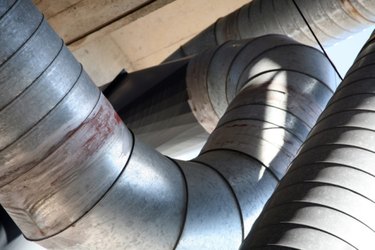Things You'll Need
Round metal pipes
Starting collars
Rectangular ducting
Takeoff
Sawhorses or portable workbenches
Ball-peen hammer
2-by-4 Board, 6 feet long
Drive cleats
Adjustable elbows
Measuring tape
Permanent marker
Tin snips
Needle-nose pliers
Screws, self-drilling, hex-head
Cordless drill
Magnetic nut-driver tip
Mastic

Metal residential duct systems are fabricated using light-gauge galvanized steel. Home systems are usually low-pressure,1/2-inch water gauge with air movement measuring less than 1,000 feet per minute in the large, main ducts. Commercial and industrial applications are much larger and drive more air, necessitating heavier gauge steel and greater joint integrity. Joining metal ductwork in your home is done through attaching metal-to-metal joints called slips and drives, and fastening them with drive cleats and self-drilling, sheet metal, hex-head screws. Residential ducting is a combination of rectangular and round channels with adjustable elbows. Measurement and cutting is done on-site.
Connecting Rectangular Ducting
Step 1
Begin rectangular ductwork at the plenum. This is the large rectangular box attached to your forced air furnace. Measure and mark the opening to the plenum into which your first rectangular piece, the takeoff, will slide.
Video of the Day
Step 2
Pierce the metal surface with your drill. Cut out the remaining opening, using tin snips.
Step 3
Insert the takeoff, tabbed end first, into the opening. Fold down the tabs inside the plenum. Drill three sheet-metal screws through the plenum and takeoff to hold the takeoff in place. Seal the joint with mastic.
Step 4
Match successive pieces of rectangular duct by placing its two half-sections on the floor with the "S-hook" ends up. Pick up one piece, and slide it into the second along the edge channels located on both.
Step 5
Suspend a 6-foot long 2-by-4 board between your sawhorses or portable work benches. Slide one end of the board through your rectangular piece of duct. Rest both ends of the board back on the sawhorses or benches. Position the connected edge channels flat on the edge of the board. Hammer the seams tight with your ball-peen hammer.
Step 6
Connect assembled rectangular sections by inserting the plain end into the S-hooks on the long edges of the next piece. Slide drive cleats through the U-channels on the short edges. Bend the ends of the drive cleats over the duct to finish the joint. Seal the finished joint with mastic.
Step 7
Measure and cut shorter lengths of rectangular duct at the plain end before putting the two pieces together as in Step 4 above.
Joining Round Metal Pipe Ducts
Step 1
Round open, nested pipe with your hands until the tongue on one seam meets the groove on the other. Slip the tongue and groove together.
Step 2
Begin at one end of the pipe, and press down the length of the seam until tongue and groove are snapped shut.
Step 3
Slide the plain end of one assembled pipe over the crimped end of the next. Push the pipes together to tighten the connection.The crimped end should point in the same direction as air flowing through the pipe.
Step 4
Space three drive screws evenly around the joint and drive them through, using your electric drill. This will secure the slip joint. Seal the joint with mastic.
Tip
Always cut smaller pieces of duct before putting them together. This is much easier than cutting assembled duct.
Warning
Take care when using tin snips. Wear leather gloves to guard against sharp cut edges.
Video of the Day